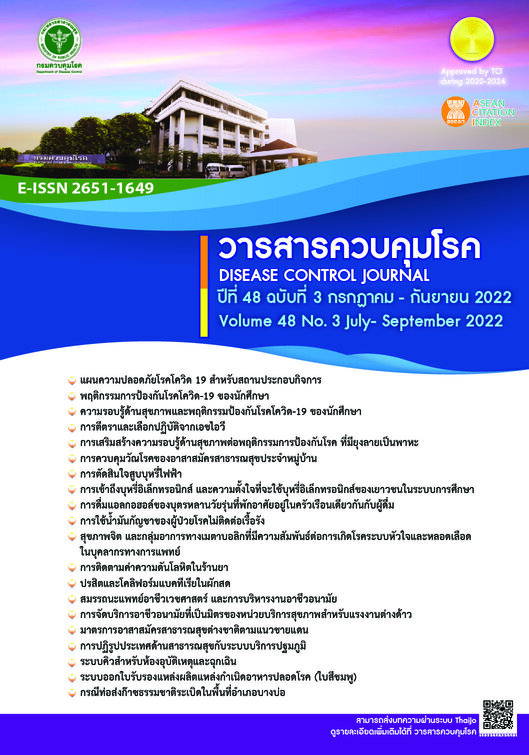Factors Associates with Intention to Use Cannabis Oil in Patients with Non-communicable Diseases in Bangkok
DOI:
https://doi.org/10.14456/dcj.2022.49Keywords:
Health Literacy, non-communicable diseases, cannabis oil useAbstract
This descriptive cross-sectional study aimed to explore the factors related to intention to use cannabis oil in patients with non-communicable diseases (NCDs) in Bangkok. A study sample was 402 NCD patients (heart disease, diabetes, and hypertension), both male and female, aged over 20 years old, and residing in the communities in Bangkok. Data were collected using structured interview questionnaires. Data were analyzed using descriptive and inferential statistics. Univariate analysis and multivariate analysis were performed to examine the factors associated with intention to use cannabis oil using Chi-square statistics and Multiple Logistic Regression, respectively. The results showed that 68.4% of the study sample were female, mean age 62.1 years old, and 57.0% received primary education (). Additionally, it was found that 24.6 % intended to use cannabis oil. About 62.7% was at low levels of knowledge related to cannabis oil (and 73.4% had insufficient levels of health literacy on cannabis oil use (The multivariate analysis revealed the factors significantly associated with the intention to use cannabis oil were good attitude of family members toward cannabis oil use (ORadj = 2.5, 95% CI = 1.3-4.4, p = 0.003), support from friends or acquaintances (ORadj = 2.7, 95%CI = 1.3-5.3, p = 0.004), and having health literacy of cannabis oil (ORadj = 4.5, 95% CI = 2.2-9.1, p <0.001). Therefore, the health literacy enhancement program related to cannabis oil use should be promoted among patients with NCDs and
Downloads
References
2. Murnion B. Medical cannabis. AustralianPrescriber. 2015;38(6):212-214.
3. United Nations Office on Drung and Crime. World Drug Report 2019. Geneva: United Nations; 2019.
4. World Health Organization. The health and social effects of nonmedical canabis use. Geneva: WHO; 2016.
5. Ebbert JO, Scarf EL, Hurt RT. Medical Canabis. Mayo Clin Proc. 2018;93(12):1842-47.
6. Department of Medical Services. Guidance on Cannabis for Medical Use. 3th ed. Nonthaburi: Department of Medical Services (TH); 2019. (In Thai)
7. Suphanchaimat R, Pavasuthipaisit C. Potential Benefits and Risks from Medicalisation and Legalisation of Cannabis. Journal of Health Systems Research. 2018;12(1):71-94. (in Thai)
8. Taupachit W, Kessombon N. Medical Use of Cannabis. Isan Journal of Phamaceutical Sciences. 2017;13:228-40. (in Thai)
9. Hazekamp A, Grotenhermen. Review on clinical studies with cannabis and canabinoids 2005-2009. Canabinoids.2010;5:1-21
10. Bridgeman MB, Abazia DT. Medicinal Cannabis: History, Pharmacology, And Implications for the Acute Care Setting. P&T. 2017;42(3):180-88.
11. Ramathibodi Poison center. The caution of using cannabis products [Internet]. Bangkok: Faculty of Medicine, Ramathibodi Hospital; 2019 [ cited 2020 Sep 6]. Available from; https://med.mahidol.ac.th/poisoncenter/sites/default/files/public/ข้อมูลกัญชาศูนย์พิษรามา%20edit.pdf
12. World Health Organization. Health Promotion Glosar. Geneva: WHO; 1998.
13. Nutbeam. Health literacy as a public health goal: challenge for contemporacy health education and commuication stratgies into the 21st century. Health Promotion International. 2000;15(3):259-67.
14. Kaeodumkoeng K. Health literacy: access, understand and application. 2nded. Bangkok: Amarin; 2018. (in Thai)
15. Srivanichakorn S. Morbidity and mortality situation of non-communicable diseases (diabetes type 2 and cardiovascular diseases) in Thailand during 2010-2014. Disease Control Journal. 2017;43(4):370-90. (in Thai)
16. Powwattana A, Kalampakron S, Lagampan S, Rawiworrakul T. Health promotion and disease prevention in community: an application of concepts and theories to practice(Revised edition). Bangkok: Faculty of Public Health, Mahidol University (TH); 2018. (in Thai)
17. Momen K , Kanato M. Development of a substance literacy scale for the Thai population. Community Health Developmend Quarterly Khon Kaen University. 2016;4(1):127-40. (in Thai)
18. Roma W, Kloyiam. Thai Health Literacy Survey(THL-S) of Thais aged 15 years and above, 2019. Nonthaburi: Health System Research Institute (TH); 2019. (in Thai)
19. Suan Sunandha Poll.The Public opinion on marijuana [Internet]. Bangkok: Suan Sunandha Rajabhat University;2019 [cited 19 Nov 2020]. Available from: https://mgronline.com/qol/detail/9620000119873 (in Thai)
20. Chaichompoo S, Shuaytong P, Waseeweerasi W, Sonkosum S. Factors Related with People’s Behavior Towards Using Medical Herbs for Illness Treatments among People in Region 11, Ministry of Public Health. Kuakarun Journal of Nursing. 2012;19(2):60-74. (In Thai)
21. Ua-Kit N, Pensri L. Utilization of the PRECEDE MODEL in Health Promotion. Thai Red Cross Nursing Journal. 2019;12(1):38-48. (in Thai)
22. Gu L, Wu S, Zhao S, et al. Association of Social Support and Medication Adherence in Chinese Patients with Type 2 Diabetes Mellitus. Int J Environ Res Public Health. 2017;14(12):1522. DOI:10.3390/ijerph14121522
23. Mondesir FL, Carson AP, Durant RW, Lewis MW, Safford MM, Levitan EB. Association of functional and structural social support with medication adherence among individuals treated for coronary heart disease risk factors: findings from the reasons for geographic and racial differences in stroke (REGARDS) study. PLoS One. 2018;13(6):e0198578. DOI:10.1371/journal.pone.0198578
24. Scheurer D, Choudhry N, Swanton KA, Matlin O, Shrank W. Association between different types of social support and medication adherence. The American Journal of Managed Care. 2012;18(12):e461-7.
25. Bains SS, Egede LE. Association of health literacy with complementary and alternative medicine use: a cross-sectional study in adult primary care patients. BMC Complement Altern Med. 2011;30(11):138. doi: 10.1186/1472-6882-11-138. PMID: 22208873; PMCID: PMC3276434.
26. Persell SD, Karmali KN, Lee JY, Lazar D, Brown T, Friesema EM, Wolf MS. Associations Between Health Literacy and Medication Self-Management Among Community Health Center Patients with Uncontrolled Hypertension. Patient Prefer Adherence. 2020;14:87-95 https://doi.org/10.2147/PPA.S226619
27. Shi Shuangjiao, Shen Zhiying, Duan Yinglong, Ding Siqing, Zhong Zhuqing. Association Between Medication Literacy and Medication Adherence Among Patients With Hypertension. Frontiers in Pharmacology. 2019.10:822 DOI=10.3389/fphar.2019.00822
28. Marvanova M, Roumie CL, Eden SK, Cawthon C, Schnipper JL, Kripalani S. Health literacy and medication understanding among hospitalized adults. J Hosp Med. 2011;6(9):488-93. DOI: 10.1002/jhm.925.
Downloads
Published
How to Cite
Issue
Section
License
Copyright (c) 2022 Disease Control Journal

This work is licensed under a Creative Commons Attribution-NonCommercial-NoDerivatives 4.0 International License.
Articles published in the Disease Control Journal are considered as academic work, research or analysis of the personal opinion of the authors, not the opinion of the Thailand Department of Disease Control or editorial team. The authors must be responsible for their articles.






